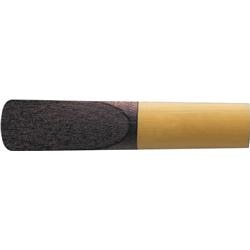June 24, 2021
Cane vs. Synthetic Reeds
I think the vast majority of saxophonists today use cane reeds. Cane is a natural product; a grass plant that is grown in moist soils, on many continents, and is grown for harvest to be made into saxophone reeds by many reed manufacturers.
Synthetic reeds are made of composite materials that are designed to imitate the quality of a reed plant and sound as much as possible, just like their cane counterparts. Early Synthetics were plastics, and the newer Synthetic reeds are better sounding and more advanced aerospace materials.
There are advantages and disadvantages to both. On a great cane reed, the sound is warmer, the response is even through all registers, the sax player has a good sense of control over the sound, and the experience is amazing. All this is said, regarding a ‘great’ cane reed.
The problem is great cane reeds can be hard to find. We already know there are dozens of reed styles, cuts, manufacturers and strengths. There is also a playability factor, and percentage of good and great reeds that you will find in any box.
Since the reed is made of a living material; some of the reed stock will be of varied quality. Manufacturers make every attempt to use the very best cane for their reeds, but not every piece of cane will produce a great reed. This creates a lot of headaches for saxophone players, digging through a new box of reeds, looking for the good ones. It also means a few are likely unplayable.
When you include the manufacturing process to the cane blanks, the outcome can further complicate the use of a cane reed if the cut is uneven or just bad. Many boxes of 10 reeds will have 2-3 great reeds, 3-4 playable reeds and a few that I throw away seconds after testing them.
Synthetic reeds lack the ‘great’ response you find in those few great cane reeds, but also lack the throw away need. Synthetic reeds are consistent. You don’t need to do much to them and they play out of the box. Different Synthetic reeds will sound different among available brands but all are very consistent.
Since saxophone players have such different set-ups and sound preferences, a wide variety of Synthetic reeds are now used by a growing number of saxophonists.
Synthetic reeds are not affected by temperature or humidity. They don’t get warped or dry out when not playing your sax. They don’t sound bad when you get off a plane in a new area that is different from your hometown, and they last much longer than cane reeds.
I think the vast majority of Synthetic reed users just got sick of dealing with cane and found a durable and consistent alternative.


I have tried them over the years, but have not made the big change to Synthetics. I have found a hybrid reed made by Rico that is a cane reed with a black plastic coating over the reed. I started playing the Rico Plasticover Reed 35 years ago and use them on alto, tenor and baritone saxophones. The response is faster than cane and the consistency is higher than cane reeds.
The goal is to find something that works for you. Understanding the benefits of each and the common disadvantages they bring is a good starting point. Major name manufacturers of Synthetic reeds include Legere, Bari, and Fibracell; available for every saxophone and in varied strengths. Just remember there are advantages and disadvantages to each, and play what works for you.






